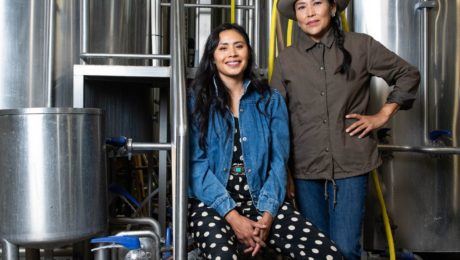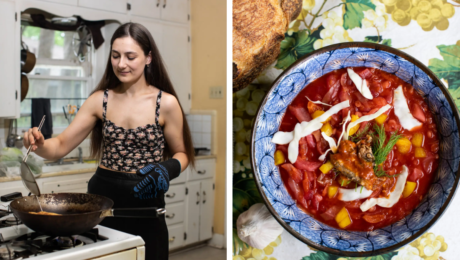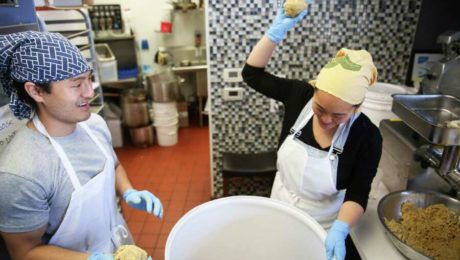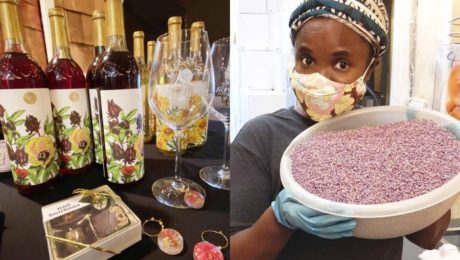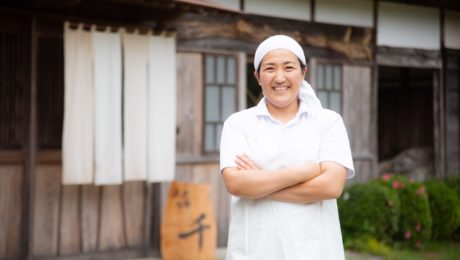Championing Indigenous Brewers
The headline says it all: “The Country’s First Native American Woman-Owned Brewery in the U.S. Doesn’t Want to Be Its Last.”
Co-founders Shyla Sheppard (who has heritage from the Three Affiliated Tribes – Mandan, Hidatsa and Arikara – of North Dakota) and her business partner and wife, Dr. Missy Begay (Diné heritage) founded Bow & Arrow Brewing Co. in 2016. The brewery has become known for wild and sour beers made with cultivated yeast. They forage for neomexicanus hops, a species found in New Mexico. Local and indigenious ingredients – like blue corn, sumac, prickly pear and juniper – are used in a new line of hard seltzers.
Bow & Arrow began a unique initiative on October 11, 2021, Indigenous Peoples’ Day. The brewery launched Native Land. They provided an IPA recipe to breweries across the U.S. to create a beer for a common mission: “to acknowledge the contributions and history of Native American people in the United States.” Participating breweries were given a can design template, which included space to acknowledge the tribal land where the brewery is located.
The campaign was so popular – 53 breweries in 24 states and one Canadian province brewed Native Land beer – that they extended the deadline for the project to September 2022. The beers are “vehicles for activism,” with a portion of proceeds going to a Native American-operated nonprofit of the brewer’s choice.
“We’re reclaiming our history and narrative. I think the contributions that Native people have had to agriculture have been erased or dismissed. It’s important to share that story to non-Native people, but also to other Native folks,” she says. “I think fostering that appreciation and connection to our history brings about healthier Native communities.”
Bow & Arrow is one of only a small number of Native-owned breweries in the U.S. – but Sheppard and Begay hope that will change and, one day, there will be more. Sheppard adds: “Having done what we’ve done — in what I hope is a respectful way of incorporating our culture and background — I think it’s inspiring other brewers.”
Read more (Eater)
- Published in Business, Food & Flavor
Fermented Foods Face Patchwork of Global Regulation & Standards
Should there be global standards for fermented foods? A new study argues “to preserve consumer confidence in fermented foods,” uniform regulations are needed.
Current guidelines “are not mature enough to adequately regulate the significant diversity of fermented foods that are increasingly available in the market,” reads the study, published in the peer-reviewed journal Frontiers in Nutrition. While fermented foods are experiencing a major resurgence in popularity, standards and regulations differ by country and – in some instances – region and state. Fermentation regulations are few and, in the case of some foods, nonexistent.
Scientists at Teagasc, Ireland (the agriculture and food authority in Ireland) studied regulations in North America, South America, Asia, Africa, Europe and Australia/New Zealand. Their research – supported by the Institute for the Advancement of Food and Nutrition Sciences (IAFNS) – is thorough. They found legislative efforts to regulate or standardize fermented foods “have been largely reactive, rather than being proactive, in nature.”
A harmonized blueprint, the study continues, would include specifics for each fermented food, not just the category. Uniform standards would include:
- Microbial and chemical composition
- Safety protocols
- Standards on storage, transportation and distribution
- Communication guidelines
- Regulatory clarity
- Government expert committee oversight
“Ultimately, addressing the challenges outlined here, would contribute to the ease of doing business, encourage consumer and investor confidence, leading to growth and innovation in this category, which in turn will catalyse overall economic progress,” the study reads.
There is also a need for a uniform regulatory framework because there is “…a visible lack of consideration of insights gained from the large corpus of microbiome studies on FFs and their microbial composition in corresponding global Food Standards or Codes.”
There is currently a Codex Alimentarius or “Food Code” by the Codex Alimentarius Commission, part of the Food Standards Programme for the United Nations Food and Agriculture Organization (FAO) and the World Health Organization (WHO). But fermented foods are not extensively represented. Regional standards have also been established by FAO and WHO, but these are generally for traditional fermented foods and beverages consumed only in certain regions, not widely used elsewhere.
The study points to South Korea and India as examples. Both countries have consolidated standards and specifications on fermented foods into legislation.
Saving Ukrainian Food Culture
When the war in Ukraine broke out, Olga Koutseridi, a Ukrainian American baker, writer and historian, felt an urgent need to preserve the traditional Ukrainian recipes she grew up with.
Koutseridi’s ancestors tended gardens outside Mariupol. They preserved the food they couldn’t eat, fermenting tomatoes, cucumbers, cabbage and sour cherries. They drank homemade kombucha, kefir and vodka. They made varenyky (dumplings stuffed with sour cherries and cheese) and chebureki (fried pastry filled with meat).
“Maybe now is not the time to celebrate Ukrainian food,” Koutseridi said. “But this feels like the only chance we have to preserve it. … Every time someone makes a Ukrainian dish in an American kitchen, it’s an act of resistance.”
Koutseridi has begun compiling these recipes, with an emphasis on history. She’s contacted Ukrainian food experts around the world (including Olia Hercules, author of Summer Kitchens).
She feels that war is destroying Ukraine’s identity, history and culture.“Now is the time to delve into{the country’s] food in detail,” Hercules said. “There’s so much more to it than borsch.”
Read more (The New York Times)
- Published in Food & Flavor
Mead’s Modern Moment
“Somewhere between wine, beer, and cider lives mead. An ancient libation like no other, mead has been a pleasant surprise to drinkers for eons. Norsemen would be thrilled to know that it has made a modern-day comeback.”
Mead was highlighted in an article in Tasting Table, “appreciated by everyone from Vikings to millennials.” Also known as honey wine, it is experiencing a modern resurgence. Mead makers are adding unique seasonings and spices to enliven their creations – but it needs to be at least 51% wine.
More meaderies are popping up – there is now at least one in every U.S. state. But liquor stores are still confused on where to put meads. The national sales manager of Chaucer’s Cellars – the country’s longest-running meadery – says most stores have no clue where to display mead.
Read more (Tasting Table)
- Published in Business, Food & Flavor
Chef’s Secret: Fermented Bean Curd
Chef Andrew Wong created the first Michelin two-star Chinese restaurant outside Asia. His London-based A Wong is an homage to China’s 3,000-year culinary history and a contemporary spin on the country’s regional cuisine.
Fermented wild sea bass and fermented coconut are part of the “Taste of China” dinner menu. A popular dish called “Why the Buddha Didn’t Jump Over the Wall” is barbecued sweet potato covered in a fermented, salted black-bean relish. It’s no surprise Wong’s favorite ingredient is fermented bean curd. He says the tofu, soaked in salt and chili, is as close to cheese as you can get in China. It’s eaten with congee and used as a condiment.
“It’s very salty; umami in its purest form,” Wong says. “I use it a lot in my cooking, especially in vegetarian dishes where we can’t use oyster sauce. We cook it out with some stock, ginger, garlic, and make a sauce. The combination of vegetables, garlic, chili and fermented bean curd creates a really deep meaty flavor.”
He advises chefs to use it like a stock cube, because it’s soft and will coat the mouth in umami flavor.
Read more (Guardian)
- Published in Food & Flavor
Scaling Artisanal Fermentation
Fungi fermenter Shared Cultures was the featured cover story in a recent Food & Wine section of the San Francisco Chronicle. Company co-owners Elena Hsu and Kevin Gondo make small-batch fermented soy sauce, miso, and sauces and marinades using koji and wild, foraged mushrooms.
The article calls Shared Cultures “the darling of the Bay Area food scene.” It details how they use traditional techniques with unexpected ingredients, like a shoyu with quinoa and lentils, a miso with cacao nib and a koji salt with leek flowers.
Hsu and Gondo also open up about the challenges of scaling artisanal fermentation. They are the only employees at the companys and can’t keep up with the demand. Their ferments require a lot of time, some fermenting for eight months in a closet-size room in their rented commercial kitchen. They note that it is too expensive to rent or purchase their own warehouse in the Bay Area.
Multiple California chefs use Shared Cultures products for an added umami punch. Hsu encourages home cooks to experiment with their products, too, “You don’t have to have a $300 tasting menu to try these flavors,” she says. “You can be the chef.”
Read more (San Francisco Chronicle)
- Published in Business, Food & Flavor
The Ancient Origins of Japanese Soy Sauce
Soy sauce is arguably the most important seasoning in Japanese cooking. Its well-balanced, salty-sweet taste and deep layer of umami richness make nearly all foods taste more delicious and satisfying. Its uses range from a dab on sushi to a splash into noodle soups and stir-fries, as well as the featured flavor of glazed dishes like teriyaki,” reads an article in BBC Travel.
The author traveled to the port town of Yuasa to learn more about the history of the “holy grail of Japanese cuisine: soy sauce.” In 2017, the country’s Agency for Cultural Affairs designated Yuasa as a Japan Heritage Site for being the birthplace of Japanese soy sauce. Soy sauce was first made in Yuasa in the 13th Century.
At its peak, the small town with a population of around 1,000 had more than 90 soy sauce breweries. Today, there are five soy sauce shops and six Kinzanji-miso makers. The decline is related to the rise of mass-produced soy sauce brands, who skimp on quality for a lower-priced soy sauce. It’s estimated that only 1% of soy sauce brewers still produce using traditional methods.
Read more (BBC)
- Published in Food & Flavor
Color of Food Culture
The United States is becoming more diverse, with 4 of every 10 Americans identifying as non-white. But grocery stores have been a poor reflection of that mix of cultures. Now, a group of BIPOC food entrepreneurs are encouraging buyers and retailers to expand the range of products featured on store shelves.
“It has to start with leadership at the top saying, ‘We have to champion emerging brands because it’s good business,’” says Clara Paye, founder of UNiTE Foods, a maker of protein bars with international flavors. “Let’s face it. Your customers are diverse. They’re looking for diverse products. Create the incentive structures for buyers out there to have those placements and do it confidently.”
Paye was part of a panel at Natural Products Expo West discussing the challenges and opportunities for founders of color. The U.S. food system, the panelists lamented, is far from equitable. For example, though foods like kimchi and miso are staples in Asian countries, shoppers are hard-pressed to find a broad and deep array of multicultural food products at a typical American grocery.
“There wasn’t an avenue if you weren’t born and raised in America,” Paye explains.
Reclaiming Food Culture
The panel stressed that they could never find the traditional foods they ate growing up when they went to American grocery stores. First- and second-generation immigrants have never been the focus of major retail food brands. Underserved in this way, these BIPOC founders say they started their companies to reconnect with the flavors of their cultures.
“We felt it was a travesty that the second largest continent in the world [Africa] didn’t have any reflection in mainstream grocery,” says Perteet Spencer, founder of Ayo Foods, which sells West African frozen dishes and jarred sauces. (Spencer — a former employee of SPINS, a retail sales data provider for natural products — spoke at a TFA webinar in 2021).
But she notes the food system is changing: “It’s clear that the market has shifted over the last several years and is embracing global flavors.”
Expanding the flavor of Mexican cuisine is the goal of Miguel Leal, co-founder and CEO of Somos, maker of Mexican meal kits.
“There’s stereotypically this (belief) that ethnic food has to be cheap,” he says. “It can be beautiful or clean or premium.”
Vanessa Pham agrees, adding there’s a narrative that authentic ethnic food should only be served in hole-in-the-wall restaurants. Pham is co-founder of Omsom, which makes chef-created Asian dishes. “Authentic” is a complicated term, she says.
“Authenticity sometimes pegs and limits food founders and chefs to a nostalgic idea, ‘How my grandma made it’ or ‘The traditional way,’” she explains. “We believe BIPOC chefs should be able to innovate. Cultural integrity is much more about doing your research, involving the right people and compensating ethically.”
Ethnic Aisle: Integrate or Celebrate?
The ethnic aisle in groceries is a debated topic among BIPOC food leaders. Some say it’s an easy way for shoppers to find international products; others argue it’s an antiquated and offensive placement.
“I like the ethnic aisle, I just don’t like the way it’s showing us today,” Leal says. “It’s a little bit of a caricature.”
A recent survey by Adobe found 66% of African Americans and 53% of Latinos feel their ethnicity is portrayed stereotypically in food advertisements.
Pham views a future where the hodgepodge of products in the ethnic aisle disappears, and rice noodles are sold next to spaghetti. Paye agrees. “I think it will be a thing of the past, a funny thing where we put candles and beans and matzo balls.”.
- Published in Business, Food & Flavor
An Overlooked Wine Category
“Aaliyah Nitoto, winemaker at Free Range Flower Winery, is tired of hearing that the category of wine is exclusive to grapes. For centuries, wine has been made from many kinds of plant products, she says, like grapes, apples, pears, rice and flowers,” reads an article in Wine Enthusiast.
The magazine highlights the history of flower wine, which has variations in the Middle East, Asia, Europe and even the U.S. The process to make the wine is different from a traditional grape wine. Fresh or dried flowers are boiled and crushed, then yeast and a sugar source are added to start the fermentation process.
Flower winemakers lament that their product is not respected in the wine industry. Flower wine has been made primarily by middle- to lower-income women.
“That can tell you right there why they were relegated to obscurity. The people who owned tracts of lands that had money and influence and got to name things like ‘noble grapes,’ they got to say what was wine and what wasn’t,” Nitoto (pictured) adds. “The opinion of people in this country over the last 100-odd years to try to get rid of this category doesn’t stand up to the history of winemaking, which is thousands of years old, which does call this wine.”
Read more (Wine Enthusiast)
- Published in Food & Flavor
Japanese Cheese
Using local microbes, sakura blossoms, sake and takesumi (bamboo charcoal), chef and microbiologist Chiyo Shibata wants to “introduce Japan through cheese.” She runs cheesery Fromage Sen in mountainous Chiba Prefecture east of Tokyo.
Shibata fell in love with cheese — not a part of a traditional Japanese diet — while visiting France as a child. She later studied microbiology and fermentation at Tokyo University, then apprenticed to cheesemakers in France. When she returned to Japan to work at a government food safety lab, cheesemaking became her side hobby. Asked to analyze the safety of dried fish maker Koshida Shouten’s 50-year-old brine, Shibata made an interesting discovery. Not only was it safe, but the brine was teaming with lactobacilli. Inspired by the world of microbes, Shibata used a sample of brine as the foundation for her Japanese cheese.
“These microbes are the way to realize the terroir unique to this place and convey the message that this is our own cheese,” she says. She opened her rural cheesery in 2014 and has since won multiple honors, including Japan Cheese and World Cheese awards. Her handcrafted cheese, made with local ingredients, is aged 2-4 weeks. “Each ingredient is good on its own, but when you bring them together, they draw out their strengths and become something even more beautiful.”
Interestingly, Eric C. Rath, a professor of Japanese history at the University of Kansas, says cheese was never traditional fare in Japan because grazing cows on the country’s rocky terrain is difficult. But ancient texts describe three things similar to cheese: so, raku and daigo. Daigo was described as “the epitome of dairy products. Buddhist monks compared its taste to enlightenment,” Rath said. It’s unknown how these dairy products were made.
Read more (Atlas Obscura)
- Published in Food & Flavor

